Why the XM25 “Punisher” grenade launcher was not needed by the army
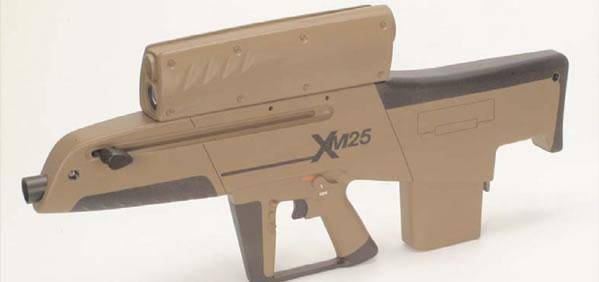
The first version of the XM25 grenade launcher
In the recent past, a promising XM25 CDTE grenade launcher, also nicknamed Punisher, was developed by order of the US Army. Using a “smart” sight and a programmable grenade, he had to solve complex fire tasks and effectively hit various targets. However, based on the results of lengthy tests and experimental military operation, the grenade launcher was not accepted for service. It had a number of shortcomings, both technical and conceptual.
In the early stages
In the nineties, the Pentagon and its contractors worked on a new generation weapons infantryman. As part of the Objective Individual Combat Weapon (OICW) program, it was planned to create an individual automatic grenade launcher system with wide combat capabilities. One of the program participants was the German company Heckler & Koch, which presented a rifle with an integrated XM29 grenade launcher.
Since the late nineties, the XM29 rifle has been tested, resulting in mixed reviews. The technical part of the project as a whole was considered successful, while the basic concept did not justify itself. In this regard, in 2003, it was decided to divide the integral model into two separate ones - a rifle and a grenade launcher.
The development of the existing grenade launcher continued within the framework of the project with the XM25 index. It provided for the development not of an under-barrel system, but of a full-fledged model in the form factor of a rifle. It was also proposed to increase the caliber, improve the sighting system, etc. To develop a new family of ammunition with broad capabilities, Alliant Techsystems (part of Orbital ATK since 2015) was involved in the project. The XM25 project was included in the military department's Counter Defilade Target Engagement (CDTE) program, which made it possible to count on future contracts.
Redesigning the finished sample did not take much time. Experimental XM25 grenade launchers and ammunition for them were sent for testing as early as 2005. These weapons were not distinguished by the perfection of their design, and over the next few years, factory tests, fine-tuning and inspections continued with the participation of Pentagon representatives. It was possible to complete the main cycle of field tests only at the turn of the decade.
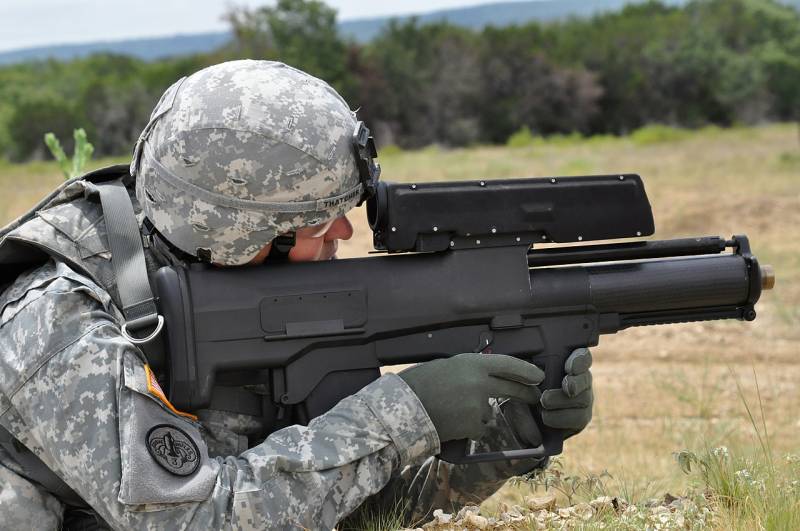
Late execution
Rifle-shaped grenade launcher
The XM25 project proposed the design of a 25 mm self-loading hand grenade launcher with rifle ergonomics. The weapon was equipped with a special electronic sight and had to use specially designed ammunition, incl. with a programmable fuse. Due to this, contact or air detonation was ensured - the latter could dramatically improve the combat qualities of the grenade launcher.
In order to reduce weight, the XM25 grenade launcher was made in a plastic case. Initially, it had a futuristic appearance, but later the design and exterior were simplified and optimized. The product was built according to the “bullpup” scheme. With a total length of approx. 750 mm it received the longest barrel. The mass of the grenade launcher without ammunition reached 6,35 kg, and the layout provided optimal balancing.
The grenade launcher received a 25 mm rifled barrel with a chamber for 25x40 mm ammunition. The weapon's automation worked by removing powder gases; the gas unit was placed on top of the barrel. The gases set in motion a massive bolt that locked the barrel by turning it. The trigger mechanism provided only single fire.
For the XM25, they developed a whole line of grenades in the standard size 25x40 mm. The main one was supposed to be high-explosive fragmentation with a programmable fuse (High-Explosive AirBursting - HEAB). Also offered were thermobaric ammunition, armor-piercing ammunition (up to 50 mm of homogeneous armor), a grenade with ready-made arrow-shaped striking elements, etc. All 25 mm grenades had the same ballistics and an initial velocity of 210 m/s. Five pieces of ammunition were placed in a box magazine.
The most important element of the new weapon was the XM104 sighting system. It was made in a large case and was mounted on top of the grenade launcher. At the same time, its individual elements were located inside the weapon, and the control buttons were located on an enlarged trigger guard in front of the handle.
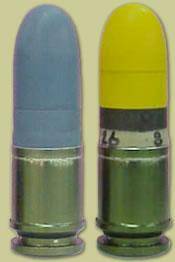
Ammunition 25x40 mm. Left - practical, right - programmable HEAB
The XM104 device included day and night optics with 2x magnification, a laser rangefinder, a compass, a ballistic computer and a programmer for working with a grenade. The shooter could find and select a target, measure the distance to it and calculate data for shooting with the output of the corresponding aiming network. The sight also provided installation of a HEAB grenade fuse using a programmer inside the grenade launcher. The latter had to count the revolutions of the grenade in flight and detonate it at a given point in the trajectory, increasing the likelihood of hitting the intended target.
According to calculations, the XM25 made it possible to conduct effective fire on single targets at a range of up to 600 m, and on group targets up to 700 m. The maximum firing range was determined to be 1 km, but at the same time the accuracy dropped sharply.
Path to failure
In 2007-2008 The XM25 grenade launcher system reached military testing, and then trial operation, both in units in the United States and abroad. Based on the results of these activities, certain comments were made, and the project was again revised. In 2010, several XM25s were sent to Afghanistan for use in real-life operations. Grenade launchers were used several times in battle, fired a large number of shots and generally showed high efficiency. In addition, among the personnel the weapon received the nickname Punisher - “Punisher”.
The successful completion of these tests allowed the Pentagon to begin developing further plans for mass production and deployment of grenade launchers among the troops. In the medium term, it was planned to purchase more than 10 thousand XM25 products and introduce them into the weapons complex of each infantry squad. For special forces it was planned to have twice as many grenade launchers. By the beginning of 2013, several contracts for the production of weapons and ammunition had been signed.
At the beginning of 2013, one of the “Afghan” grenade launchers exploded in the shooter’s hands during firing practice. As it turned out, there was a double supply of ammunition and one of the charges ignited when the barrel was unlocked. The XM25 was heavily damaged and the grenade launcher was wounded. Fortunately, the grenades did not explode, and there were no more serious consequences. However, this incident had a very serious impact on the entire CDTE development program.
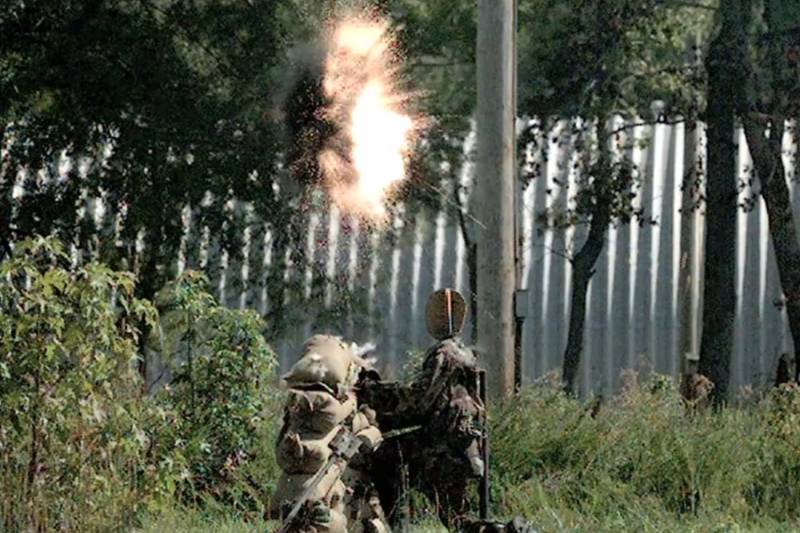
Aerial detonation of a HEAB grenade
It was decided to remove the new grenade launchers from units in Afghanistan and carry out another design modification. After this, further tests took place, following which the product was again sent for fine-tuning. During these activities, some of the newly identified deficiencies were eliminated, and a new version of the XM104 sight was introduced.
In August 2016, the Inspector General of the US Department of Defense, having studied the situation with the XM25 project, demanded that a final decision be made on it - to bring the grenade launcher into operation or to close the project. In April of the following year, the Pentagon terminated the contract with Orbital ATK due to failure to fulfill its terms. In addition, Orbital filed a lawsuit against Heckler-Koch due to legal and production delays.
In July 2018, the Pentagon officially stopped work on the XM25 / CDTE topic. Also, the customer and the contractors signed a document on the conditions for terminating development. In accordance with it, all rights to the developments in the closed project remained with the army.
Reasons for failure
Thus, 15 years of active work on the XM25 grenade launcher, not counting the previous XM29 project, did not produce the desired result. The resulting weapon, with all its advantages, did not suit the customer. In addition, the contractors failed to organize its production. As a result, the project, worth several tens of millions of dollars, was closed.
The XM25 project was based on an interesting idea. It was planned to create a hand-held grenade launcher with high firing characteristics and optimal ergonomics. To improve combat qualities, a grenade with a programmable fuse and a “smart” sight for controlling it were added to the complex. The possibility of contact or air detonation, as well as the availability of other types of ammunition, gave the XM25 product the widest possible capabilities.
However, the implementation of this idea was not the most successful. The resulting grenade launcher had a lot of technical shortcomings that had to be corrected over the course of many years. In addition, some of his problems began at the conceptual level, and it was almost impossible to cope with them.
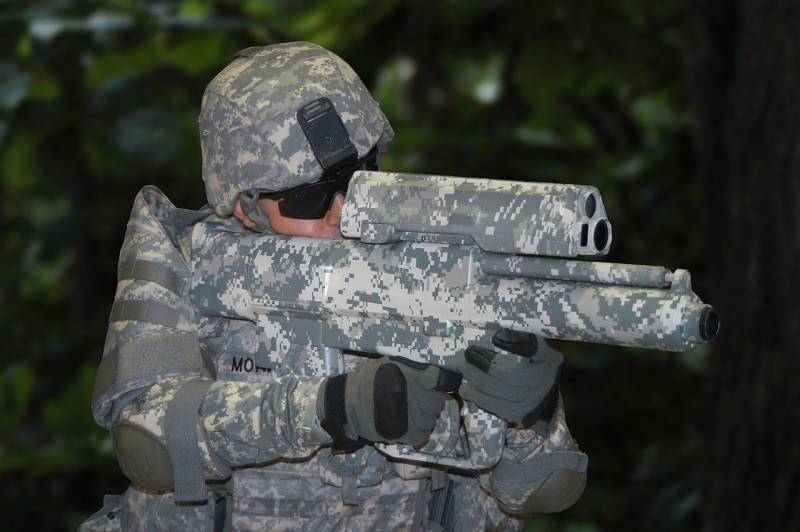
The XM25 grenade launcher had an acceptable length, but was bulky. In addition, it turned out to be too heavy - 6,35 kg without ammunition. The weapon and standard ammunition of 7 magazines weighed approx. 16 kg. Because of this, the average rifleman could only carry and use a grenade launcher. Use as an additional weapon along with a standard rifle was not possible, which could worsen the overall capabilities of the unit.
High requirements and fundamentally new functions have led to a more complex design and the emergence of corresponding technical risks. As a result, the complex came out for testing with a number of shortcomings of various types and scales. During development, the XM25 and its ammunition went through several stages of development, and each time tests showed the need for further refinement. It is unknown whether it would have been possible to bring the grenade launcher into full compliance with the customer’s requirements.
With all this, the XM25 and its grenades turned out to be prohibitively expensive. According to the plans of the mid-tenths, even with large-scale production, the cost of a grenade launcher should have reached 35 thousand dollars. The grenades of the first batches had to be assembled by hand, and each cost approx. $1K Automated gross production was expected to reduce costs.
Negative experience
History The XM25 project shows some of the features and problems of the process of creating fundamentally new weapons systems. Heckler & Koch and Orbital ATK managed to create a new grenade launcher with special capabilities that generally corresponds to the general views and desires of the customer. At the same time, the resulting design had an excessive number of shortcomings and compromises.
During fine-tuning, testing and new stages of refinement, we managed to get rid of some of the shortcomings. However, improving the design risked turning into an endless process without clear prospects and with constant expenses. The Pentagon did not take risks and closed the project due to the lack of the desired results within a reasonable time frame. In addition, as we now know, they decided to abandon the very idea of a hand-held grenade launcher in the form of a rifle using special ammunition. Whether they will ever decide to return to such concepts is unknown.
Information